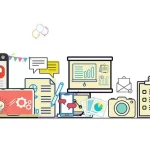
The Concept
This is the simplest way of explaining the way by which an organisation whether product or customer-centred interacts with its customers and prospects. It explains the process that a customer or prospect passes through before deciding to purchase or use a particular product or service. Understanding the customer Life Cycle will help organizations to guide against losing customers to competitors.
The Concept
This is the simplest way of explaining the way by which an organisation whether product or customer-centred interacts with its customers and prospects.
It explains the process that a customer or prospect passes through before deciding to purchase or use a particular product or service.
Understanding the customer Life Cycle will help organizations to guide against losing customers to competitors.
| At the end of this article, readers should be able to:
|
It will also help them to attract new prospects to their own life cycle.
The Customer Life Cycle you should know begins with reaching the target market and progresses towards an established loyal customer base.
Along the way, it is necessary to acquire, convert and retain customers.
The Customer Life Cycle (CLC) is a circle that any organization will want its best customer to move around over and over again.
This is because as customers purchase your products, they are learning about your organization over and over again.
I can even say that they are learning some new things. You should know that these processes may change from company to company the processes that lead to it are different from company to company The noticeable differences at times may be attributed to product consideration.
When a customer is considering using a particular product from your organisation, he or she is termed as a prospect.
In doing this, lie has to go through a lot of thought processes in order to decide whether or not to use your product. His conclusion will determine whether or not he will enter your Life Cycle.
When a customer enters the Life Cycle of any organisation, there are six basic things that they do.
#1 Identify needs
They try to identify needs that may be filled by a product or service available for purchase from the enterprise.
Let’s take for example an organisation is offering Tomato paste for sale. You have to think of needs that can be satisfied with that.
#2 Identify products
After you have identified those products and the needs that they can satisfy at times you have to tell others about it.
You can help the organisation to create awareness about the existence of those products or services.
#3 Determine satisfaction
The next thing is to find time to learn more about the organisation and the products and services they have to offer.
You may also want to know about other products and services that WON’ nave in stock.
#4 Consider the product
Now you have to consider how the products and services offered by the organization satisfy or do not satisfy your needs.
#5 Evaluate the suitability
You evaluate the suitability of the products and services against the competition to fulfil the identified needs.
#6 Purchase product
The decision to purchase the product or service or go to another competition.
The last phase in the customer Life Cycle is often regarded as the “Customer moment”. This is the time when the customers decide whether or not to purchase the product.
As soon as he decides to purchase the product, he becomes a customer. This decision will also change the focus of the organization.
They are now concerned with how they will not lose hard-earned customers to their competitors. They can now influence the customer either positively or negatively.
You should know that if the organisation fails to live up to expectation through poor services or falling short of the brand promise, this can make the customer to join another organization’s Life Cycle.
But if they are able to satisfy his needs, he becomes a customer for life. At this stage, the customer continues to acquire products from the organisation and utilize it.
This may continue through the entire lifetime of the customer. Once the customer is satisfied, he will re-enter the organization’s Life Cycle and start the process over and over again.
You should know that while the customer goes through the Life Cycle, he might be lost at any stage in the Life Cycle but it is also agreed upon that, it is better for you to lose a prospect than to lose a hard-earned customer.
If the loss of hard-earned customers continues uncontrolled, it is often referred to as “Customer attrition”,
There are two ways by which a prospect or a customer can drop out of the Life Cycle.
The first one is known as “loss”; this is when you lost a prospect to your competitor just before they enter your Life Cycle.
While nobody prays that this kind of loss should occur but at least it is desirable.
This is due to the fact that you have not invested your hard-earned money on the prospects before they enter your competitor’s Life Cycle.
The second form of loss that can happen to an organization is called attrition which is more than an ordinary loss. It happens when your hard-earned customers decide to join your competitors’ Life Cycle.
Attrition has been defined as the erosion of customer loyalty after the customer moment leading to their capture by a competitor.
This kind of loss is painful as you have already invested in them. Such loss, should not occur when you can provide acceptable service to your customers.
You should know that competition is one of the factors that influence movements in the CLC. One thing that determines the level at which an organisation need to be customer-centric has much to do with the level of competition that an organisation is facing from its competitors.
The final goal of a customer-centric enterprise is to raise the exit harrier so that prospects are not easily lost to competitors and attrition of hard-earned customers is totally prevented.
Customer Life Cycle Management
The business processes conducted by the organisation fall into the following general categories.
#1 Intrude And Engage
Under this, the organization intends to catch the prospect’s attention, and increase the prospect’s awareness of the organisation.
Tell him about what the organization has to offer and engage him in a discussion that is targeted at drawing him into the organization’s Life Cycle.
#2 Transact and Fulfill
That the prospects are aware of the organization and what it has to offer, does not guarantee that the prospect is going to purchase the organization’s product or service.
That is why the organization has to continually engage the prospects so as to ensure that they finally become the organization’s customers.
#3 Retain/Service and Expand
Once the customer purchases your product or service, you have to begin real work of ensuring that you do not lose him to your competitor.
This involves coming up with innovations that will ensure that you continually satisfy your customers and live up to the expectation of your customers.
Do you enjoy this article, add Our Posts to your Reading List.
Action Point
PS: I know you might agree with some of the points raised in this article or disagree with some of the issues raised.
Please share your thoughts on the topic discussed. We would appreciate it if you could drop your comment. Thanks in anticipation.
WhatsApp: @CRMNuggets Community
Follow Us on Facebook: CRMNuggets
Follow on X Platform
Follow on TikTok @crmnuggets
Telegram: Join Here





Leave a Reply